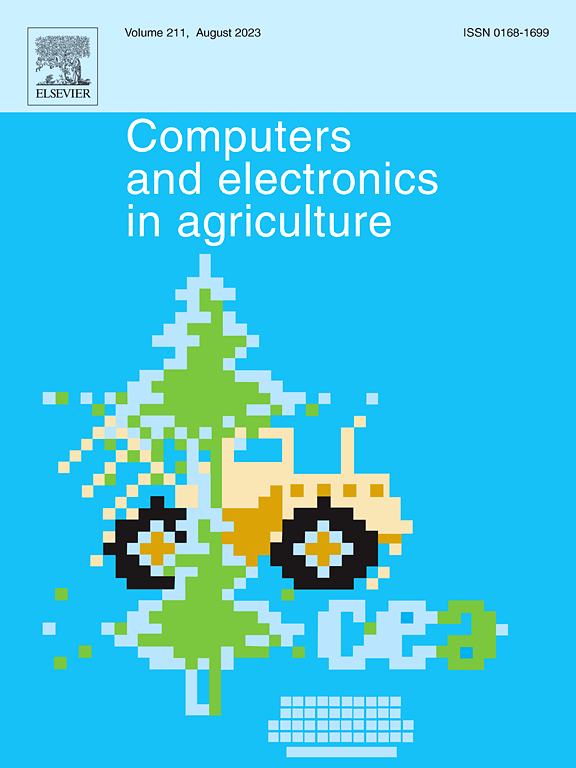一种用于农业机械轨迹运行模式识别的双层交互级联网络
IF 8.9
1区 农林科学
Q1 AGRICULTURE, MULTIDISCIPLINARY
引用次数: 0
摘要
农业机械轨迹运行模式识别是指利用海量轨迹数据中的时空特征识别农业机械的运行模式,并为每个未知轨迹点分配相应的语义标签的过程。然而,现有的研究主要是探索局部区域内相邻轨迹点之间的特征相互作用,未能充分探索不同范围内农机轨迹之间的依赖关系。为实现农业机械轨迹运行模式的高效识别,提出了一种用于农业机械轨迹运行模式识别的双层交互级联网络(DIANet)。首先,设计多视图特征提取(MFE)模块,快速扩展轨迹特征集的规模,从物理和统计两个不同的角度充分挖掘轨迹点的潜在信息;其次,为了挖掘农业机械轨迹在不同范围内的依赖关系,我们提出了一种双级交互自编码器(DIA),该编码器由两个模块组成:信息关注上下文模块(IAC)和邻域挖掘上下文模块(NMC)。最后,设计双掩模自监督学习(DSL)模块对模型进行预训练,学习更一般的轨迹特征表示,提高模型的泛化能力。为了验证该模型的有效性,在农业农村部农业大数据重点实验室提供的两个轨迹数据集上与其他方法进行了比较。该数据集共包含180个轨迹样本和超过1,000,000个轨迹点。在水稻收割机和拖拉机轨迹数据集上,我们的模型分别获得了90.74%和94.54%的F1分数,与目前最先进的方法相比,分别提高了6.15%和7.2%。本文章由计算机程序翻译,如有差异,请以英文原文为准。
A dual-level interactive cascade network for agricultural machinery trajectory operation mode identification
Agricultural machinery trajectory operation mode identification refers to the process of using the spatiotemporal features in massive trajectory data to identify the operation mode of agricultural machinery and assign corresponding semantic labels to each unknown trajectory point. However, existing research has explored mainly the feature interactions between adjacent trajectory points in local areas and has failed to explore the dependencies of agricultural machinery trajectories in different ranges fully. To achieve efficient identification of the agricultural machinery trajectory operation mode, we propose a dual-level interactive cascade network (DIANet) for agricultural machinery trajectory operation mode identification. First, we design a multi-view feature extraction (MFE) module to quickly expand the size of the feature set of the trajectory, fully exploring the potential information of trajectory points from two different perspectives, physics and statistics. Second, to mine the dependencies of agricultural machinery trajectories in different ranges, we propose a dual-level interactive autoencoder (DIA), which consists of two modules: the information attention context module (IAC) and the neighborhood mining context module (NMC). Finally, we design a dual-masked self-supervised learning (DSL) module to pretrain the model to learn more general trajectory feature representations to improve the generalization ability of the model. To verify the effectiveness of the proposed model, our model was compared with other methods on two trajectory datasets provided by the Key Laboratory of Agricultural Big Data, Ministry of Agriculture and Rural Affairs. The dataset covers a total of 180 trajectory samples and more than 1,000,000 trajectory points. On the paddy harvester and tractor trajectory datasets, our model achieved F1 scores of 90.74 % and 94.54 %, respectively, which are improvements of 6.15 % and 7.2 % compared with those of the current state-of-the-art methods.
求助全文
通过发布文献求助,成功后即可免费获取论文全文。
去求助
来源期刊

Computers and Electronics in Agriculture
工程技术-计算机:跨学科应用
CiteScore
15.30
自引率
14.50%
发文量
800
审稿时长
62 days
期刊介绍:
Computers and Electronics in Agriculture provides international coverage of advancements in computer hardware, software, electronic instrumentation, and control systems applied to agricultural challenges. Encompassing agronomy, horticulture, forestry, aquaculture, and animal farming, the journal publishes original papers, reviews, and applications notes. It explores the use of computers and electronics in plant or animal agricultural production, covering topics like agricultural soils, water, pests, controlled environments, and waste. The scope extends to on-farm post-harvest operations and relevant technologies, including artificial intelligence, sensors, machine vision, robotics, networking, and simulation modeling. Its companion journal, Smart Agricultural Technology, continues the focus on smart applications in production agriculture.
 求助内容:
求助内容: 应助结果提醒方式:
应助结果提醒方式:


